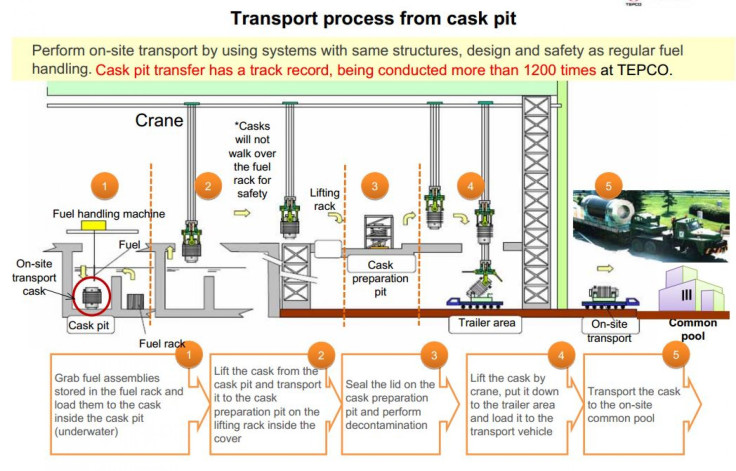Tepco Begins Dangerous Transfer Of Nuclear Fuel Rods At Fukushima Nuclear Power Plant
Japan on Monday began an extremely dangerous, yet essential, task of removing nuclear fuel rods at the tsunami-hit Fukushima Daiichi facility, as part of the plant’s decades-long decommissioning process.
Tokyo Electric Power, or Tepco, the plant’s beleaguered operator, in a statement said that workers at the nuclear facility have begun the process of removing uranium and plutonium fuel rods from a storage pool in its Unit 4 reactor, and moving them to a common storage pool equipped with better precautionary measures.
"At 15:18 (0618 GMT), we started to pull up the first fuel assembly with a crane," a company spokesman said Monday, adding that the entire process of transferring the rods, which are rolled in to bundles called "fuel assemblies" would take more than a year.
The technically tricky operation, which is the first major step in a decades-long journey toward the safe decommissioning of the wrecked plant, comes after a series of setbacks and accidents, such as multiple radioactive water leaks from the facility, delayed the process.
Tepco has been widely criticized for its mismanagement of the crisis at the nuclear power plant, which was hit by a giant tsunami triggered by an earthquake in March 2011, which ravaged the facility and damaged its back-up generators and cooling system. A power-supply failure damaged the reactors at Unit 1, Unit 2 and Unit 3, leading to their partial meltdown.
Unit 4 was not in operation at the time the tsunami hit the facility, and hence, all of its fuel rods were in the storage pool. However, hydrogen from Unit 3 escaped into Unit 4, causing an explosion that tore off its roof.
Now, Tepco's engineers have started removing more than 1,500 fuel assemblies -- in batches of 22 -- from the storage pool, using a newly-constructed crane fitted with a remote-controlled grabbing tool.

Tepco has reportedly taken elaborate precautions for the operation, but experts warn that the present conditions of the rods are unknown and any slip-up could further delay the decommissioning process.
“Tepco will continue to pursue this work with the highest level of health and safety of our workers, the population and the environment,” Naomi Hirose, president of Tepco, said in a statement.
The current process of removing the assemblies, although an unprecedented step and extremely risky, is still much less dangerous than the arduous task that lies ahead of removing the nuclear cores at the three remaining units, which went into meltdown before being brought under control two years ago.
A live stream of the fuel assembly transfer operations at Unit 4 can be viewed here.
© Copyright IBTimes 2024. All rights reserved.






















